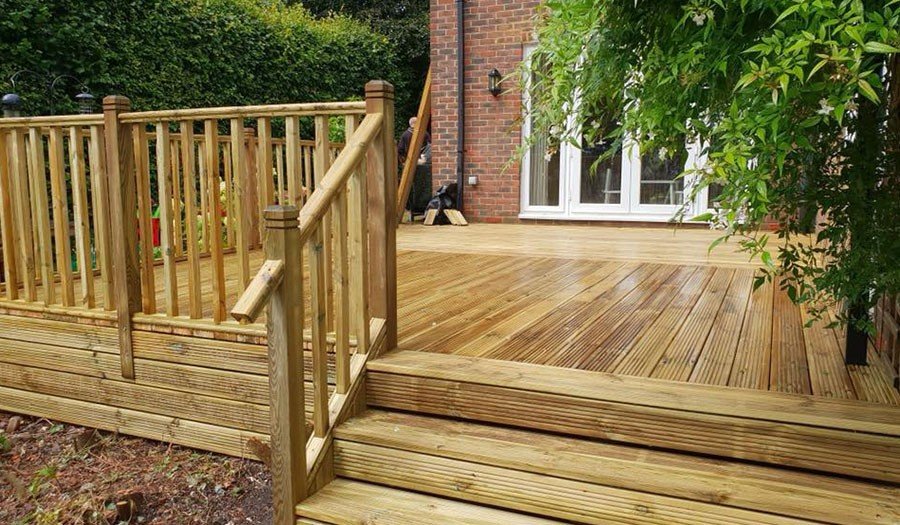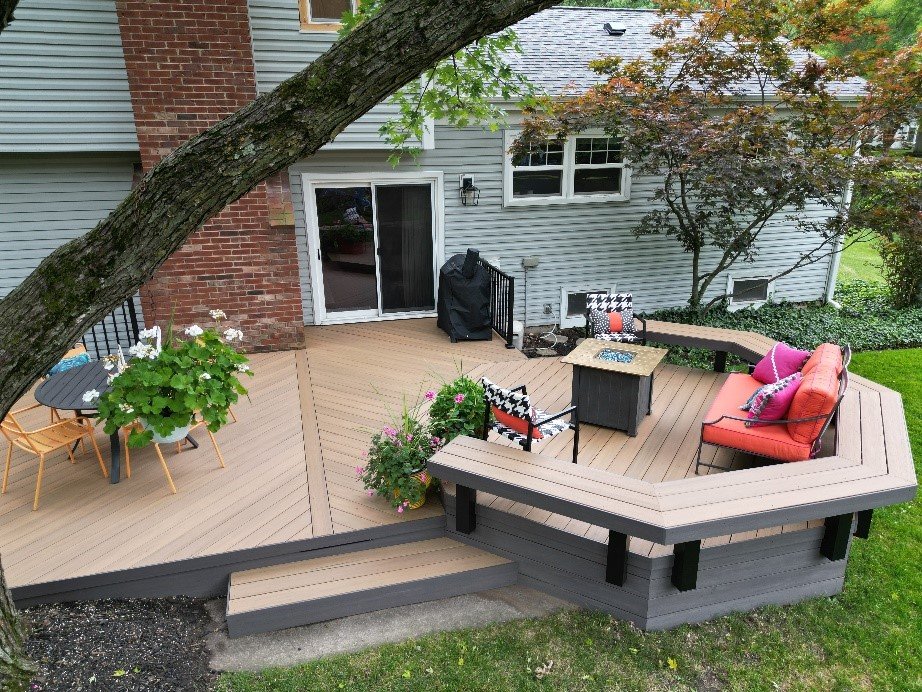When planning to build a new deck or replace an old one, choosing the right material is crucial for both durability and aesthetics. With so many options available, each with its unique benefits, it’s easy to feel overwhelmed. As 2025 approaches, the latest trends and innovations in deck materials are making it easier than ever to create the outdoor space of your dreams. Whether you’re looking for sustainability, low maintenance, or something that offers a natural feel, this guide will help you navigate the best deck material options for the upcoming year.
Let’s dive into the most popular choices and how you can select the one that fits your lifestyle and budget.
Composite Decking: The Leading Choice
Composite decking has been the gold standard for outdoor spaces for many years, and in 2025, it continues to be the top contender. Made from a blend of wood fibers and plastic, composite decking offers a low-maintenance solution that stands up to the elements.
Why Choose Composite Decking?
Composite decking requires little upkeep compared to traditional wood. It doesn’t splinter, fade, or warp, making it ideal for families with kids or pets. Plus, it’s available in a wide range of colors and textures, mimicking the look of wood without the hassle of staining or sealing every year.
Additionally, many composite decking brands have made strides in sustainability, using recycled materials in their production. With eco-friendly options, composite decking is perfect for homeowners looking to go green.
Considerations for Composite Decking
While composite decking is a strong choice, it can be pricier than traditional wood. However, its longevity and minimal maintenance often justify the higher upfront cost. If you want to create a deck that lasts, composite is hard to beat.
Pressure-Treated Wood: A Budget-Friendly Option

Pressure-treated wood has long been a popular choice for decking due to its affordability and accessibility. This type of wood is chemically treated to resist moisture, insects, and decay, making it a durable option for outdoor spaces.
Benefits of Pressure-Treated Wood
One of the main advantages of pressure-treated wood is its cost-effectiveness. It’s generally much cheaper than composite and other deck materials. If you’re on a tight budget or prefer the classic look of wood, pressure-treated lumber is a solid choice.
Pressure-treated wood can also be stained or painted to suit your design preferences. It offers versatility in terms of style, allowing you to customize it to fit your vision.
Things to Keep in Mind
Pressure-treated wood does require maintenance, such as resealing or staining every few years. It also has a tendency to warp, crack, or splinter over time. However, with proper care, it can still last for many years.
PVC Decking: Durability Meets Low Maintenance
PVC decking is made entirely from plastic, which means it’s resistant to water, insects, and rot. Unlike composite decking, which includes wood fibers, PVC decking is 100% synthetic and requires virtually no maintenance.
Advantages of PVC Decking
One of the primary benefits of PVC decking is its low-maintenance nature. It doesn’t need to be stained or sealed and is highly resistant to fading. PVC is also available in a wide range of colors and finishes, making it a customizable option for homeowners looking for something that’s both durable and stylish.
Additionally, PVC decking tends to be lighter than composite or wood, making it easier to handle during installation.
Considerations for PVC Decking
While PVC is incredibly durable, it can be more expensive than pressure-treated wood or composite decking. However, if you value a completely low-maintenance deck, the investment can be well worth it in the long run.
Aluminum Decking: The Ultimate in Durability
Aluminum decking is gaining popularity, especially in high-end applications. Known for its incredible durability, aluminum decking is resistant to rust, corrosion, and weathering.
Why Aluminum Decking Is Worth Considering
Aluminum decks are extremely durable and can withstand extreme weather conditions without showing signs of wear. They’re a great option for coastal areas where saltwater exposure can damage other materials. Plus, they’re lightweight, making installation easier and quicker.
Aluminum decking is also highly customizable. Some systems feature hidden fasteners and interlocking joints, creating a smooth, seamless surface.
Considerations for Aluminum Decking
While aluminum decking offers longevity and strength, it is one of the more expensive options on the market. However, if you’re looking for a material that will last a lifetime with minimal maintenance, aluminum is a top choice.
Hardwood Decking: Classic Beauty and Strength
For homeowners who love the rich, natural appearance of wood, hardwood decking offers a stunning alternative. Species like ipe, teak, and mahogany are known for their dense, resilient qualities that make them ideal for outdoor use.

Benefits of Hardwood Decking
Hardwoods are naturally beautiful and provide a timeless, luxurious feel to any outdoor space. They’re incredibly strong, offering superior resistance to wear and tear. With the right care, hardwood decking can last for decades, developing a natural patina over time.
If you’re willing to put in the effort, hardwood decking can provide an elegant and sophisticated touch to your home.
Considerations for Hardwood Decking
Hardwood decking requires regular maintenance, including oiling and cleaning, to keep it looking its best. It’s also one of the most expensive decking materials, so it’s important to consider your budget before choosing this option.
Concrete Decking: A Modern Twist on Traditional Decking
Concrete decking isn’t the first material that comes to mind when thinking of outdoor decks, but it’s becoming increasingly popular due to its durability and design flexibility. Whether used as a solid concrete surface or with concrete pavers, this material offers a sleek, contemporary look.
Benefits of Concrete Decking
Concrete is incredibly durable and low-maintenance. It’s resistant to rot, insects, and fading. Concrete decks are also highly customizable, allowing homeowners to choose various textures and finishes, such as stamped or stained designs.
Concrete is ideal for those looking for a modern, minimalist look that requires little upkeep over the years.
Considerations for Concrete Decking
While durable, concrete can be prone to cracking if not properly installed or if exposed to significant temperature fluctuations. Additionally, concrete decking can be cold and hard underfoot, making it less comfortable for lounging or outdoor dining.
How to Choose the Right Deck Material for Your Home
With so many great decking materials available in 2025, how do you choose the right one? Consider the following factors when making your decision:
1. Budget
If cost is a major factor, pressure-treated wood or composite might be your best bet. For a long-lasting investment, you may want to consider aluminum or PVC, despite the higher upfront costs.
2. Maintenance
Some materials, like composite and PVC, require minimal upkeep. If you’re looking for something low-maintenance, these materials should be at the top of your list.
3. Aesthetic Preferences
Hardwood decking offers a natural, classic look, while PVC and composite come in a variety of colors and finishes to suit modern tastes. Choose what fits your style and complements your home.
4. Climate and Weather
Consider your local climate when selecting materials. If you live in a coastal area, aluminum may be the most durable option. If you’re in a hot, dry area, composite decking can handle the sun’s rays without fading.
Wrapping Up: The Best Deck Materials
Choosing the best deck material for your home depends on your priorities—whether it’s cost, maintenance, appearance, or durability. With options like composite, PVC, and aluminum on the market, there’s something for everyone. As we approach 2025, investing in a high-quality decking material is an excellent way to enhance your outdoor living space.
FAQs
1. Which deck material is the most affordable?
Pressure-treated wood is generally the most affordable decking material, but it requires regular maintenance.
2. Does composite decking fade over time?
While composite decking is designed to resist fading, it may lose some of its vibrancy over time, especially in high-sun areas.
3. How often should I maintain my deck?
Wood decks require maintenance every 1-2 years, while composite and PVC decks generally need little upkeep beyond cleaning.
4. Is aluminum decking worth the investment?
Aluminum decking is highly durable and low-maintenance, making it a great long-term investment if you’re willing to pay a premium upfront.

